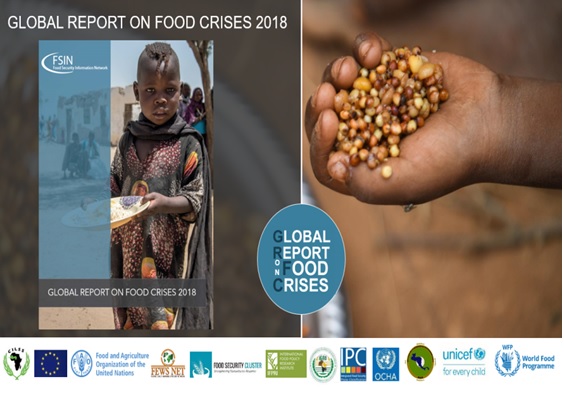The Global Food Crisis Report 2018 at DEVCO Info point on 18th April
Discussion details
Following the launch of the Global Report on Food Crises 2018 in Rome on 22nd March 2018 and in Geneva on 12th April 2018, DEVCO C1 organized on 18th April 2018 an InfoPoint Lunchtime Conference focused on the results of this joint analysis on global food crises.

Deputy Head of Unit C1 Bernard Rey introduced the two guests Dominique Bourgeon, FAO Director for the Emergency and Rehabilitation Division (TCE) and Strategic Programme Leader on Resilience, together with Arif Husain, WFP Deputy Director for the Policy, Programme and Innovation Division, who in turn presented the latest estimates of severe hunger in 51 countries facing a food crisis. Across the world, around 124 million people were affected in 2017.
According to the report, conflict and insecurity continued to be the primary drivers of food insecurity in 18 countries, where almost 74 million food-insecure people remain in need of urgent assistance. There are moreover, very high rates of acute child malnutrition in areas affected by conflict (such as, North Darfur in Sudan, South Sudan, the Lake Region in Chad, and Northern Nigeria). Globally, 155 million children under-five are stunted (suffering from low height respective to their weight) of which 122 million (80 percent) live in fragile and conflict-affected states.
Consecutive climate shocks affecting livestock and agricultural production are the second driver of food crises. 15 countries in Africa - particularly northern Kenya, Ethiopia and Madagascar – are home to almost 32 million food-insecure people. Three countries in South Asia – and in particular Pakistan/Sindh province - include over 4 million food insecure people; and five countries in Latin America and the Caribbean host over 3 million food insecure people.
Overall, efforts to address food crises were able to avert major risks of famine. However, the total number of people in urgent need has increased compared to 2016 and previous years. The four most severe food crises have been in Yemen – 17 million (60% increase), South Sudan – 6.1 million (50%), Somalia – 3.3 million (27%), and Northeast Nigeria – 5.2 million (34%).
The report also stresses that humanitarian funding requirements have more than doubled – from some 2.9 billion USD in 2013 to more than 6.5 billion USD in 2017, with a current funding gap to address these crisis of 29% across all countries. However, a coherent approach to food crises requires in addition to humanitarian aid, investment in prevention and strengthening resilience to food crises. The Global Report is the first product of the “Global Network against food crises” launched at the World Humanitarian Summit of 2016 in Istanbul and provides an opportunity to move from joint analysis to consensus building and ultimately to better coordination in addressing food crises along the humanitarian/development/peace nexus .
This report, which is the second such edition, was prepared collectively by 12 leading global and regional institutions (see photo) under the umbrella of the Food Security Information Network. The Global Report is now perceived as a global public good and as a reference document for use by all those committed to achieving the objective of minimizing human suffering and eventually ending hunger.
The full global report and summary reports can be found in French, Spanish, English and Arabic and are available here. The power point presentation given at the info-point conference is attached below.

Log in with your EU Login account to post or comment on the platform.